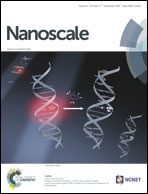ZEB1 knockdown mediated using polypeptide cationic micelles inhibits metastasis and effects sensitization to a chemotherapeutic drug for cancer therapy†
Abstract
Metastasis and drug resistance are the main causes for the failure in clinical cancer therapy. Emerging evidence suggests an intricate role of epithelial-mesenchymal transition (EMT) and cancer stem cells (CSCs) in metastasis and drug resistance. The EMT-activator ZEB1 is crucial in malignant tumor progression by linking EMT-activation and stemness-maintenance. Here, we used multifunctional polypeptide micelle nanoparticles (NP) as nanocarriers for the delivery of ZEB1 siRNA and doxorubicin (DOX). The nanocarriers could effectively deliver siRNA to the cytoplasm and knockdown the target gene in H460 cells and H460 xenograft tumors, leading to reduced EMT and repressed CSC properties in vitro and in vivo. The complex micelle nanoparticles with ZEB1 siRNA (siRNA–NP) significantly reduced metastasis in the lung. When DOX and siRNA were co-delivered by the nanocarriers (siRNA–DOX–NP), a synergistic therapeutic effect was observed, resulting in dramatic inhibition of tumor growth in a H460 xenograft model. These results demonstrated that the siRNA–NP or siRNA–DOX–NP complex targeting ZEB1 could be developed into a new therapeutic approach for non-small cell lung cancer (NSCLC) treatment.


 Please wait while we load your content...
Please wait while we load your content...